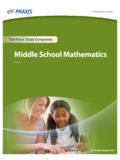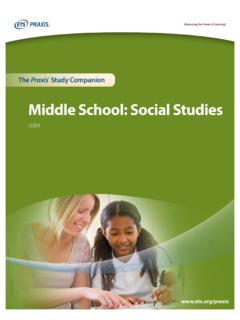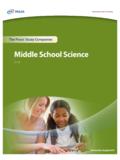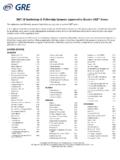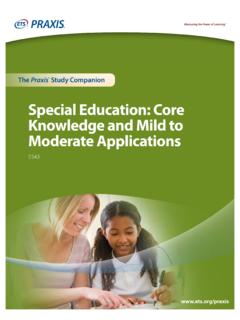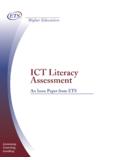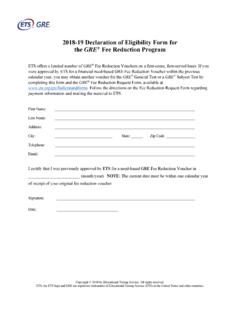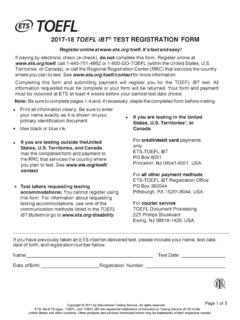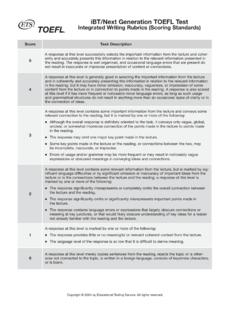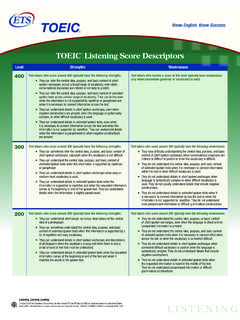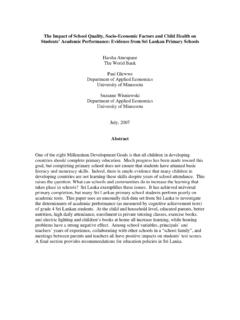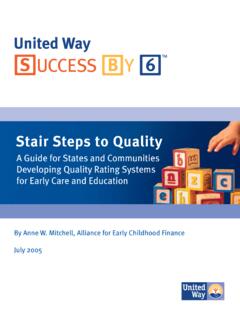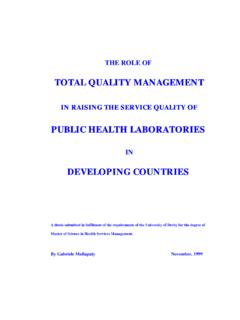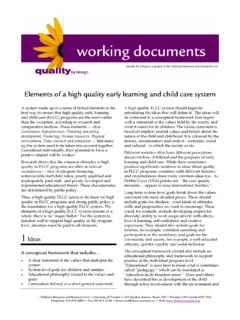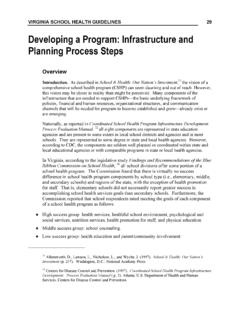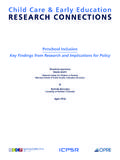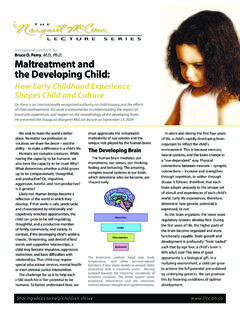Transcription of Innovative Policies & Practices for Developing …
1 Innovative Policies & Practices for Developing Teachers to Work with English Language LearnersMargarita Calder nJohns Hopkins University2 Talking Points Exiguous research on teacher development. Some Innovative approaches. Implications for policy and further 18: Professional Development Research There are features unique to professional development of teacher who work with language minority students. Creating change in teachers is a time-consuming process and involves an outside collaborator. Professional development must be continuous throughout the school year, for several years. Practices and beliefs have no particular order. Beliefs change with training and application in the classroom. Well-trained coaches make a difference in teacher and student outcomes.
2 (National Literacy Panel for Language Minority Children and Youth, 2006)4 TRAINING DESIGN Workshops Courses Learning Communities Coaching Observations Other professional activity teacher IMPACT teacher knowledge Instructional repertoire Frequent & systematic use Student adaptation Quality instruction STUDENT IMPACTD ifference between experimental & control student gains in the domain that their teachers received the training ( vocabulary)Relationship Between Training, teacher & Student Outcomes5 TRAINING MEASURES Scientific- based sources Practical application Teachers interaction & handling of strategies Relevancy to intended student populationTRANSFER MEASURES Classroom observation instruments Video analyses Student work analyses Coaching Collegial activitiesSTUDENT MEASURES Vocabulary pre- post-tests Discourse protocols Reading -- decoding, fluency, comprehension pre- post-tests Monthly writing samplesExample.
3 Vocabulary6 TRAINING EXAMPLEW orkshops on vocabulary Reading and discussing research in TLCs Modeling/ demos and observations on teaching vocabulary to ELLsTEACHER TRANSFER EXAMPLE Cites sources & summarizes publications Vocabulary pre- post-test Uses 5-10 strategies to teach vocab. Invites teachers to observe/video tapeSTUDENT IMPACT EXAMPLES Masters 5-10 words daily Uses new words in daily speech, retells Increased reading fluency, comprehension Uses new words in writingSOME INDICATORS:7 Training ProgramInitial teacher knowledge and skillStagnation or erosion of knowledge & skillNo impact on studentsFollow up coaching and school-based TLCsStage 2 teacher skill & knowledgeAdditional training, Coaching and TLCs Stage 3 instructional expertise, use & comfortIMPACT ON STUDENTSEXPECTED teacher AND STUDENT RESULTS15 - 20 days a year plus weekly TLCs and coaching 8 Time Devoted to Staff Development and Implementation of BCIRC Components STUDENT IMPROVEMENT IN READINGLowHighMedium(Calder n, Hertz-Lazarowitz 1998)9 Forecasting Transfer Without CoachingASODFMAMJJANJA nticipationDisillusionmentReenergizingRe flectionTerminationCalder n, M.
4 (1984) A Study of Coaching and It s Impact on TO BURNOUTENTHUSIASMSTAGNATIONFRUSTRATIONAP ATHY11 Statistical Trends in Secondary Schools Nationally, over 6 million American students in grades 6 through 12 are at risk of failure because they read and comprehend below often considerably below the basic levels needed for success in high school, postsecondary education, and the workforce. 69%-90% of ELLs in middle and high school were born in the United States; they are second- or third-generation immigrants - - and have been in U. S. schools since kindergarten! Newcomers, refugees -- are mainly SIFE (Students with Interrupted Formal Education).12 SIFE = Student with Interrupted Formal Education in grades 4 through 12 who either/or: is a newcomer with two or more years of education interrupted in his/her native country; attended school in the U.
5 S., returned to his/her native country for a period of time, then returned to the again; attended kindergarten in English (L2), 1st and 2nd grade in (L1), then jumped into L2 in 3rd; or any strange combination thereof. has attended schools since kindergarten but has language and literacy gaps due to ineffective instruction; attends school in one location for a few months, then moves to another location for a few months, and perhaps has some weeks in between these changes when he/she does not attend York City Schools and others have found that: Literacy interventions for native English speakers will not work for ELLs. Adolescent ELLs generally need much more time focused on Developing vocabulary and background schema than native English speakers do.
6 ESL-only programs do not work. Elementary-level programs do not work for adolescents. Phonics-only programs do not work. It must be a program that integrates scope of tier 1, tier 2, tier 3 programs for language and literacy development, along with subject matter THE ON CURRENT RESEARCH, ELLs NEED A BALANCE OF Depth ofVocabularyReading and Writing in ContentDomains16 PHONEMIC,PHONOLOGICAL & SEMANTICAWARENESSRICH LANGUAGEP racticeSTUDY SKILLSREADING COMPREHENSIOND epth & Breadth ofWORD KNOWLEDGEACADEMICSUBJECTSGRAMMAR,SYNTAX, DISCOURSEVOICEWRITING IN THEDIFFERENT SUBJECT AREASINTEGRATION OF INSTRUCTION, MATERIALS, ASSESSMENT & PROFESSIONAL DEVELOPMENT17 Reading to LearnEnglish language learners (ELLs) are learning English at the same time they are studying core content through English.
7 They must perform double the work of native speakers to keep up, and at the same time be accountable for AYP (Carnegie Panel on ELL Literacy).Without explicit instruction on reading each subject area, students cannot learn math, science, social studies and literature(NRC Commission on teacher Preparation).18 Teaching Vocabulary / ConceptsWhy depth and breadth of vocabulary? Vocabulary knowledge correlates with comprehension. Comprehension depends on knowing between 90% and 95% of the words in a text. To overcome the vocabulary disadvantage, we need to teach vocabulary explicitly on a daily basis. A high achieving 12th-grader has learned some 15 words a day, over 5000 words a 1- SIFE 2- LONG-TERM ELL 3- INTERMEDIATE ELLV ocabulary Syntax Pronunciation ProsodyPhonemic Awareness PhonicsReading Comprehension Strategies and SkillsWriting Mechanics and Composition for All SubjectsDomain Knowledge 20 Evidence-based programs that helped NYC teachers demonstrate AYP with SIFE and ELLs.
8 TIER 1 -- ExC-ELL -- Expediting Comprehension for English Language Learners (K - 12th) -- professional development program for mainstream teachers on how to integrate language and literacy development along with subject 2 & 3 -- RIGOR -- Reading Instructional Goals for Older Readers (4th - 12th) -- science and social studies curriculum lessons with leveled readers, CDs, benchmark and pre- post- assessments, in English and develop, implement, and refine a staff development program, instructional design for teachers of language arts, science, and social studies who have English- language learners (ELLs) in their classrooms, and a system for monitoring student and teacher progress and New York Carnegie Corporation funded ExC-ELL (2003-08) to:22 RIGOR for Students with Interrupted Formal Education (SIFE) in Middle and High Schools who are at thePreliterate to LowPreliterate to Low--literate Grade 3 literate Grade 3 reading levelsreading levelsAnd have missed 2 or more years of schooling in their native country or in schools23An ELL Tier 1 and Tier 2 MODEL WHEREESLSPEDANDELA,MATH,SCIENCE,SOCIAL STUDIESTEACHERS WORK TOGETHERE merging Literacy and Language teachersScience teachersSocial Studies teachersLanguage ArtsteachersMath teachers24 Tiers 1 & 2 Implementation25 Current Study.
9 Middle School ELLs in Special Education Response To Intervention (RTI) relies on a multi- level prevention system to identify students with LDs: Primary prevention level Secondary prevention level Tertiary prevention level Schools in New York incorporate 3 tiers of intervention using ExC-ELL and RIGOR. Opportunity to study teachers Basics Primary Prevention: All students screened to determine which students are suspected to be at risk. Students suspected to be at risk remain in primary prevention, with short-term progress monitoring (6-8 weeks). Short-term progress monitoring used to Disconfirm risk. These responsive students remain in primary Confirm risk. These unresponsive students move to secondary CAN MAINSTREAM TEACHERS ACCURATELY DETERMINE WITHOUT APPROPRIATE PREPARATION?
10 27 RTI Basics Secondary Prevention: Research-based tutoring protocol Provided in small groups With weekly progress monitoring At end of tutoring trial, progress monitoring indicates students were Responsive to secondary preventative tutoring. Responsive students return to primary prevention, but progress monitoring Unresponsive to secondary preventative tutoring. Unresponsive students move to tertiary prevention (special education).ELL READING SPECIALISTS OR teacher ASSISTANTS?28 RTI Basics Tertiary Prevention: More intensive, special education services Weekly progress monitoring to enhance AYP Set Individualized Education Program (IEP) goals Design individualized instructional programs Monitor student response When progress monitoring indicates the student is on track to achieve benchmark, student returns to primary or secondary prevention, with ongoing progress SPECIAL EDUCATION teacher PREPARATION?
